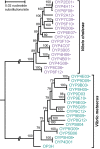Genomes of Vibrio metoecus co-isolated with Vibrio cholerae extend our understanding of differences between these closely related species
- PMID: 36404338
- PMCID: PMC9677704
- DOI: 10.1186/s13099-022-00516-x
Genomes of Vibrio metoecus co-isolated with Vibrio cholerae extend our understanding of differences between these closely related species
Abstract
Background: Vibrio cholerae, the causative agent of cholera, is a well-studied species, whereas Vibrio metoecus is a recently described close relative that is also associated with human infections. The availability of V. metoecus genomes provides further insight into its genetic differences from V. cholerae. Additionally, both species have been co-isolated from a cholera-free brackish coastal pond and have been suggested to interact with each other by horizontal gene transfer (HGT).
Results: The genomes of 17 strains from each species were sequenced. All strains share a large core genome (2675 gene families) and very few genes are unique to each species (< 3% of the pan-genome of both species). This led to the identification of potential molecular markers-for nitrite reduction, as well as peptidase and rhodanese activities-to further distinguish V. metoecus from V. cholerae. Interspecies HGT events were inferred in 21% of the core genes and 45% of the accessory genes. A directional bias in gene transfer events was found in the core genome, where V. metoecus was a recipient of three times (75%) more genes from V. cholerae than it was a donor (25%).
Conclusion: V. metoecus was misclassified as an atypical variant of V. cholerae due to their resemblance in a majority of biochemical characteristics. More distinguishing phenotypic assays can be developed based on the discovery of potential gene markers to avoid any future misclassifications. Furthermore, differences in relative abundance or seasonality were observed between the species and could contribute to the bias in directionality of HGT.
Keywords: Comparative genomics; Evolution; Horizontal gene transfer; Vibrio cholerae; Vibrio metoecus.
© 2022. The Author(s).
Conflict of interest statement
The authors declare that this study received funding from the Bank of Montréal Financial Group. The funder was not involved in the study design; collection, analysis, and interpretation of data; the writing of this article; and the decision to submit it for publication.
Figures




Similar articles
-
The Dynamics of Genetic Interactions between Vibrio metoecus and Vibrio cholerae, Two Close Relatives Co-Occurring in the Environment.Genome Biol Evol. 2015 Oct 9;7(10):2941-54. doi: 10.1093/gbe/evv193. Genome Biol Evol. 2015. PMID: 26454015 Free PMC article.
-
Vibrio metoecus sp. nov., a close relative of Vibrio cholerae isolated from coastal brackish ponds and clinical specimens.Int J Syst Evol Microbiol. 2014 Sep;64(Pt 9):3208-3214. doi: 10.1099/ijs.0.060145-0. Epub 2014 Jun 27. Int J Syst Evol Microbiol. 2014. PMID: 24972615
-
Simultaneous Quantification of Vibrio metoecus and Vibrio cholerae with Its O1 Serogroup and Toxigenic Subpopulations in Environmental Reservoirs.Pathogens. 2020 Dec 16;9(12):1053. doi: 10.3390/pathogens9121053. Pathogens. 2020. PMID: 33339261 Free PMC article.
-
Epidemiology & molecular biology of Vibrio cholerae O139 Bengal.Indian J Med Res. 1996 Jul;104:14-27. Indian J Med Res. 1996. PMID: 8783504 Review.
-
Dynamics in genome evolution of Vibrio cholerae.Infect Genet Evol. 2014 Apr;23:32-41. doi: 10.1016/j.meegid.2014.01.006. Epub 2014 Jan 23. Infect Genet Evol. 2014. PMID: 24462909 Review.
References
-
- Islam MT, Alam M, Boucher Y. Emergence, ecology and dispersal of the pandemic generating Vibrio cholerae lineage. Int Microbiol. 2017;20:106–115. - PubMed
LinkOut - more resources
Full Text Sources

